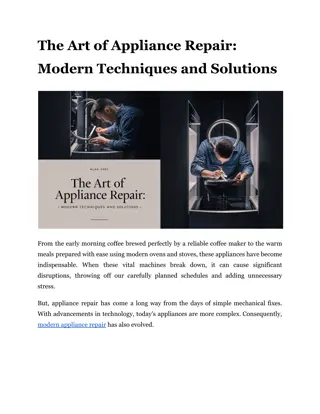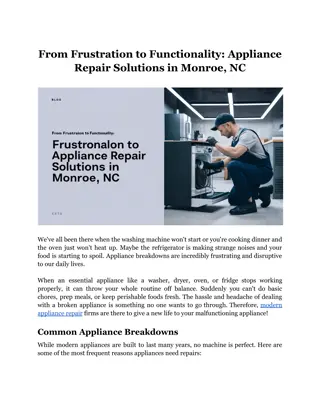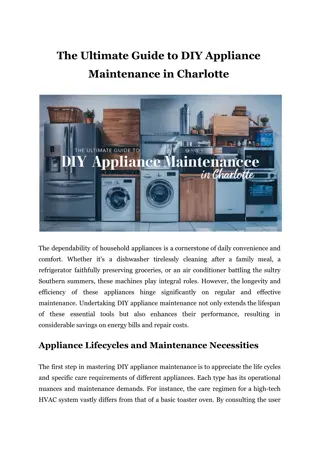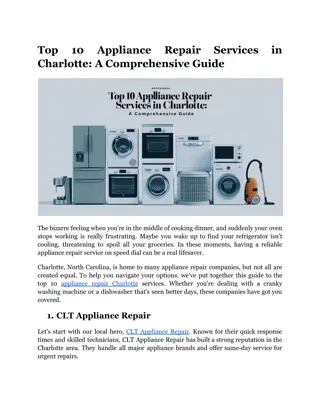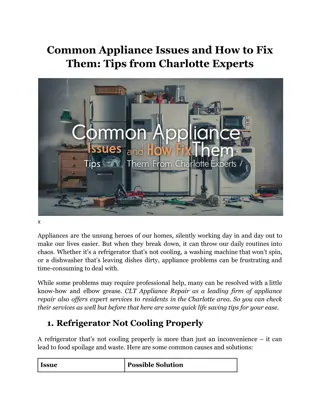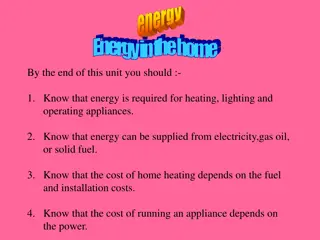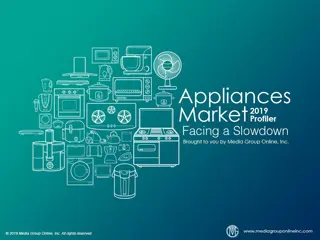Maximizing Savings Through Appliance Standards
Appliance and equipment standards have led to significant reductions in energy consumption for refrigerators, clothes washers, and dishwashers over the years. These standards not only save consumers money but also contribute to CO2 reductions. By updating existing standards, there are further opportunities for substantial savings in utility bills and environmental impact by 2050.
Download Presentation

Please find below an Image/Link to download the presentation.
The content on the website is provided AS IS for your information and personal use only. It may not be sold, licensed, or shared on other websites without obtaining consent from the author.If you encounter any issues during the download, it is possible that the publisher has removed the file from their server.
You are allowed to download the files provided on this website for personal or commercial use, subject to the condition that they are used lawfully. All files are the property of their respective owners.
The content on the website is provided AS IS for your information and personal use only. It may not be sold, licensed, or shared on other websites without obtaining consent from the author.
E N D
Presentation Transcript
Savings from Appliance Standards Joanna Mauer Appliance Standards Awareness Project CFA Member Briefing October 7, 2020
Background Appliance and equipment standards specify minimum efficiency levels for specific products Apply to appliances and equipment manufactured or imported for sale into the U.S. First national standards established in 1987 ~ 60 products covered by existing standards 2
Historical declines in energy use: refrigerators 1,500 25 Energy use (kWh/year) and Adjusted volume (cu. ft.) 19% 1,200 20 increase in volume 1990 standard 900 15 1993 standard 54% decrease in energy consumption 600 10 2001 standard 2014 standard 300 5 0 0 1985 1990 1995 2000 2005 2010 2015 Energy use (kWh/yr) Adjusted volume (cu. ft.) 3
Historical declines in energy use: clothes washers 4.5 Energy use (kWh/cycle) and Tub volume (cu. ft.) 4.0 3.5 49% increase in tub volume 3.0 2.5 75% decrease in energy consumption 2.0 1994 standard 1.5 1.0 2004 standard 0.5 2007 standard 0.0 1985 1990 1995 2000 2005 2010 2015 Energy use (kWh/cycle) Tub volume (cu. ft.) 4
Historical declines in energy use: dishwashers 3.0 2.5 53% decrease in energy consumption Energy use (kWh/cycle) 2.0 1994 standard 1.5 2010 standard 1.0 2013 standard 0.5 0.0 1985 1990 1995 2000 2005 2010 2015 kWh/cycle 5
As refrigerator, clothes washer, and dishwasher energy consumption has decreased . . . Performance generally stayed the same or improved Products included new features Prices declined 6
Existing standards are providing large utility bill savings and CO2 reductions $500/year in savings for an average household $63 billion in utility bill savings in 2015 $2 trillion in cumulative utility bill savings through 2030 7.9 billion tons in cumulative CO2 reductions through 2030 7
But there are still huge opportunities for additional savings In 2016, we found that by 2050, updates to existing standards could: Save consumers and businesses $65 billion on their annual utility bills Reduce annual CO2 emissions by 200 MMT Up-to-date estimates coming soon . . . 8
Trump administration has failed to deliver any of these savings No updates to standards completed 28 missed deadlines for reviewing appliance standards Rollback of light bulb standards Revised Process Rule Others in the works 9
States have stepped up States adopting state-level appliance standards since 2018 10
Future potential savings: water heaters Gas water heaters: >20% savings Electric water heaters: >60% savings Heat pump Conventional Condensing Electric resistance 12
Additional large potential future savings ACs/heat pumps: 10-15%+ savings Refrigerators/ freezers: 15-20% savings Furnaces: 20% savings Clothes dryers: 30% savings Faucets: 20-45% savings Showerheads: 30% savings 13
Joanna Mauer 505-508-2910 jmauer@standardsASAP.org www.appliance-standards.org 14




